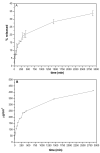Wound Dressing: Combination of Acacia Gum/PVP/Cyclic Dextrin in Bioadhesive Patches Loaded with Grape Seed Extract
- PMID: 35335859
- PMCID: PMC8948950
- DOI: 10.3390/pharmaceutics14030485
Wound Dressing: Combination of Acacia Gum/PVP/Cyclic Dextrin in Bioadhesive Patches Loaded with Grape Seed Extract
Abstract
The success of wound treatment is conditioned by the combination of both suitable active ingredients and formulation. Grape seed extract (GSE), a waste by-product obtained by grape processing, is a natural source rich in many phenolic compounds responsible for antioxidant, anti-inflammatory, and antimicrobial activities and for this reason useful to be used in a wound care product. Bioadhesive polymeric patches have been realized by combining acacia gum (AG) and polyvinylpyrrolidone (PVP). Prototypes were prepared by considering different AG/PVP ratios and the most suitable in terms of mechanical and bioadhesion properties resulted in the 9.5/1.0 ratio. This patch was loaded with GSE combined with cyclic dextrin (CD) to obtain the molecular dispersion of the active ingredient in the dried formulation. The loaded patch resulted mechanically resistant and able to release GSE by a sustained mechanism reaching concentrations able to stimulate keratinocytes' growth, to exert both antibacterial and antioxidant activities.
Keywords: acacia gum; bioadhesion; grape seed extract; patch; wound.
Conflict of interest statement
The authors declare no conflict of interest.
Figures











Similar articles
-
Grape seed extract-soluplus dispersion and its antioxidant activity.Drug Dev Ind Pharm. 2020 Aug;46(8):1219-1229. doi: 10.1080/03639045.2020.1788059. Epub 2020 Jul 13. Drug Dev Ind Pharm. 2020. PMID: 32643446
-
Delivery of natural polyphenols by polymeric nanoparticles improves the resistance of endothelial progenitor cells to oxidative stress.Eur J Pharm Sci. 2013 Nov 20;50(3-4):393-9. doi: 10.1016/j.ejps.2013.08.008. Epub 2013 Aug 26. Eur J Pharm Sci. 2013. PMID: 23988846
-
Development and Characterization of Xanthan Gum and Alginate Based Bioadhesive Film for Pycnogenol Topical Use in Wound Treatment.Pharmaceutics. 2021 Mar 3;13(3):324. doi: 10.3390/pharmaceutics13030324. Pharmaceutics. 2021. PMID: 33802607 Free PMC article.
-
Incorporation of grape seed extract towards wound care product development.3 Biotech. 2021 Jun;11(6):261. doi: 10.1007/s13205-021-02826-4. Epub 2021 May 11. 3 Biotech. 2021. PMID: 33996373 Free PMC article. Review.
-
Grape seed extract: having a potential health benefits.J Food Sci Technol. 2020 Apr;57(4):1205-1215. doi: 10.1007/s13197-019-04113-w. Epub 2019 Sep 30. J Food Sci Technol. 2020. PMID: 32180617 Free PMC article. Review.
Cited by
-
Exploring bioadhesion: insight on innovative strategies to investigate bioadhesive scaffolds.Int J Pharm X. 2025 Jul 15;10:100359. doi: 10.1016/j.ijpx.2025.100359. eCollection 2025 Dec. Int J Pharm X. 2025. PMID: 40735389 Free PMC article. Review.
-
Anionic Polysaccharide Cryogels: Interaction and In Vitro Behavior of Alginate-Gum Arabic Composites.Polymers (Basel). 2023 Apr 11;15(8):1844. doi: 10.3390/polym15081844. Polymers (Basel). 2023. PMID: 37111992 Free PMC article.
-
Polymeric Patches Based on Chitosan/Green Clay Composites and Hazelnut Shell Extract as Bio-Sustainable Medication for Wounds.Pharmaceutics. 2023 Jul 31;15(8):2057. doi: 10.3390/pharmaceutics15082057. Pharmaceutics. 2023. PMID: 37631271 Free PMC article.
-
In Vitro Anticancer Activity of Mucoadhesive Oral Films Loaded with Usnea barbata (L.) F. H. Wigg Dry Acetone Extract, with Potential Applications in Oral Squamous Cell Carcinoma Complementary Therapy.Antioxidants (Basel). 2022 Sep 28;11(10):1934. doi: 10.3390/antiox11101934. Antioxidants (Basel). 2022. PMID: 36290658 Free PMC article.
-
Analysis of the Influence of Both the Average Molecular Weight and the Content of Crosslinking Agent on Physicochemical Properties of PVP-Based Hydrogels Developed as Innovative Dressings.Int J Mol Sci. 2022 Oct 1;23(19):11618. doi: 10.3390/ijms231911618. Int J Mol Sci. 2022. PMID: 36232921 Free PMC article.
References
-
- Nutan B., Chandel A.K.S., Jewrajka S.K. Liquid Prepolymer-Based in Situ Formation of Degradable Poly(ethylene glycol)-Linked-Poly(caprolactone)-Linked-Poly(2-dimethylaminoethyl)methacrylate Amphiphilic Conetwork Gels Showing Polarity Driven Gelation and Bioadhesion. ACS Appl. Bio Mater. 2018;1:1606–1619. doi: 10.1021/acsabm.8b00461. - DOI - PubMed
-
- Nutan B., Chandel A.K.S., Bhalani D.V., Jewrajka S.K. Synthesis and tailoring the degradation of multi-responsive amphiphilic conetwork gels and hydrogels of poly(β-amino ester) and poly(amido amine) Polymer. 2017;111:265–274. doi: 10.1016/j.polymer.2017.01.057. - DOI
-
- Augustine R., Hasan A., Dalvi Y.B., Rehman S.R.U., Varghese R., Unni R.N., Yalcin H.C., Alfkey R., Thomas S., Al Moustafa A.E. Growth factor loaded in situ photocrosslinkable poly(3-hydroxybutyrate-co-3-hydroxyvalerate)/gelatin methacryloyl hybrid patch for diabetic wound healing. Mater. Sci. Eng. C. 2021;118:111519. doi: 10.1016/j.msec.2020.111519. - DOI - PubMed
-
- Gruppuso M., Turco G., Marsich E., Porrelli D. Polymeric wound dressings, an insight into polysaccharide-based electrospun membranes. Appl. Mater. Today. 2021;24:101148. doi: 10.1016/j.apmt.2021.101148. - DOI
LinkOut - more resources
Full Text Sources
Molecular Biology Databases

